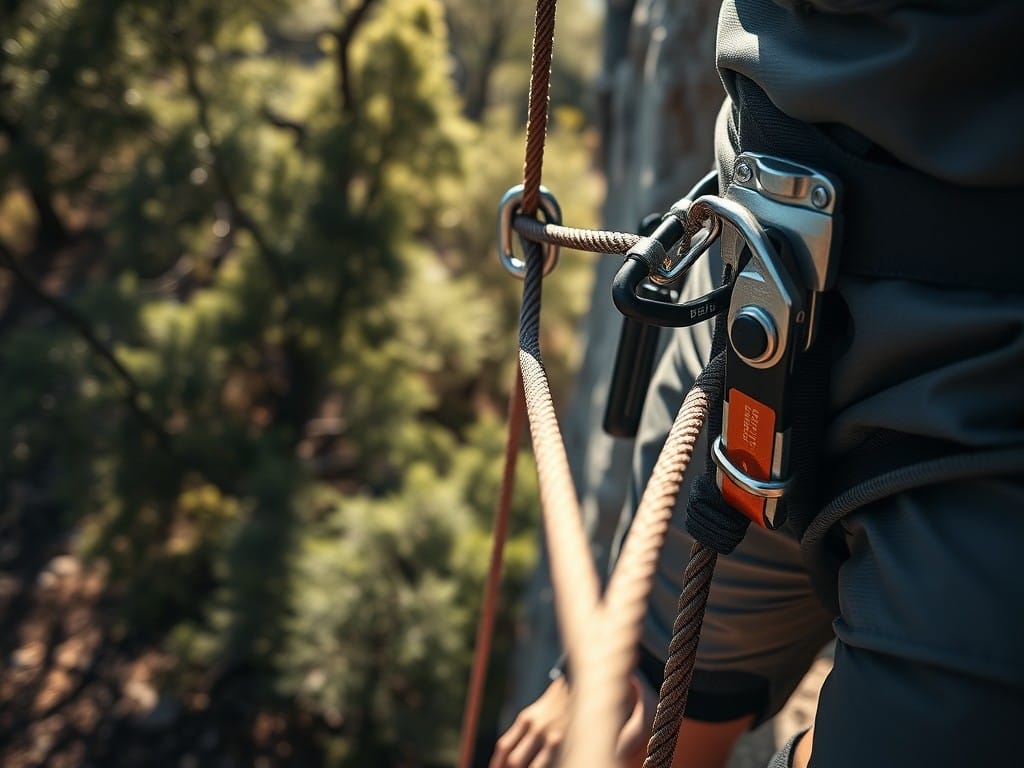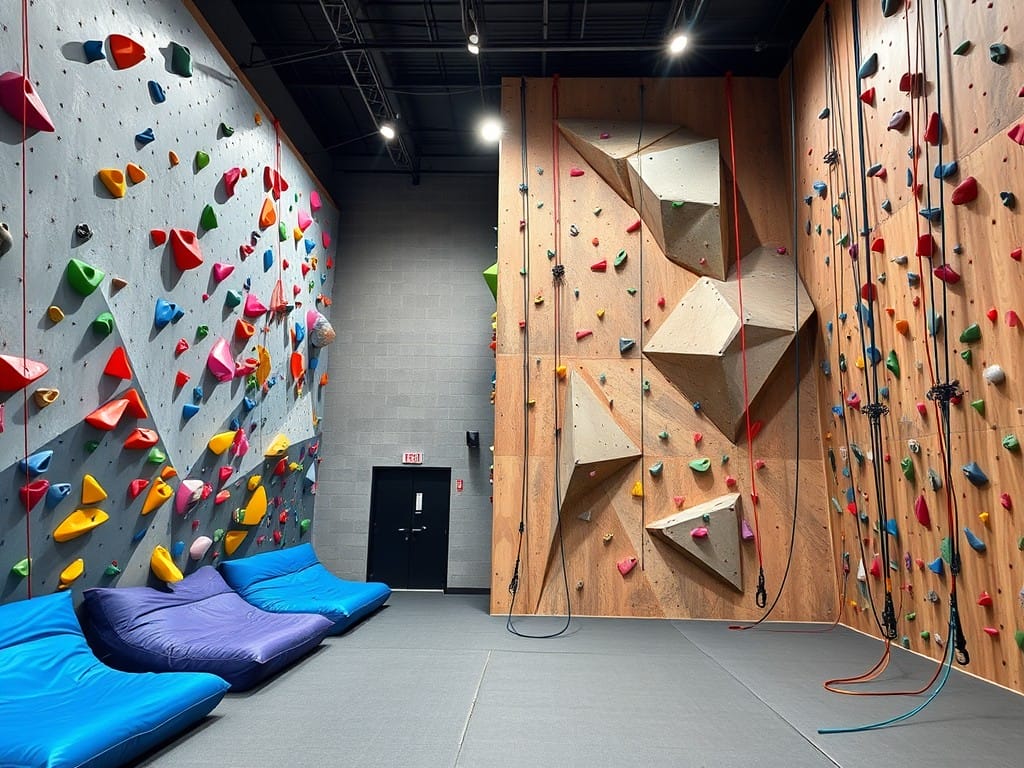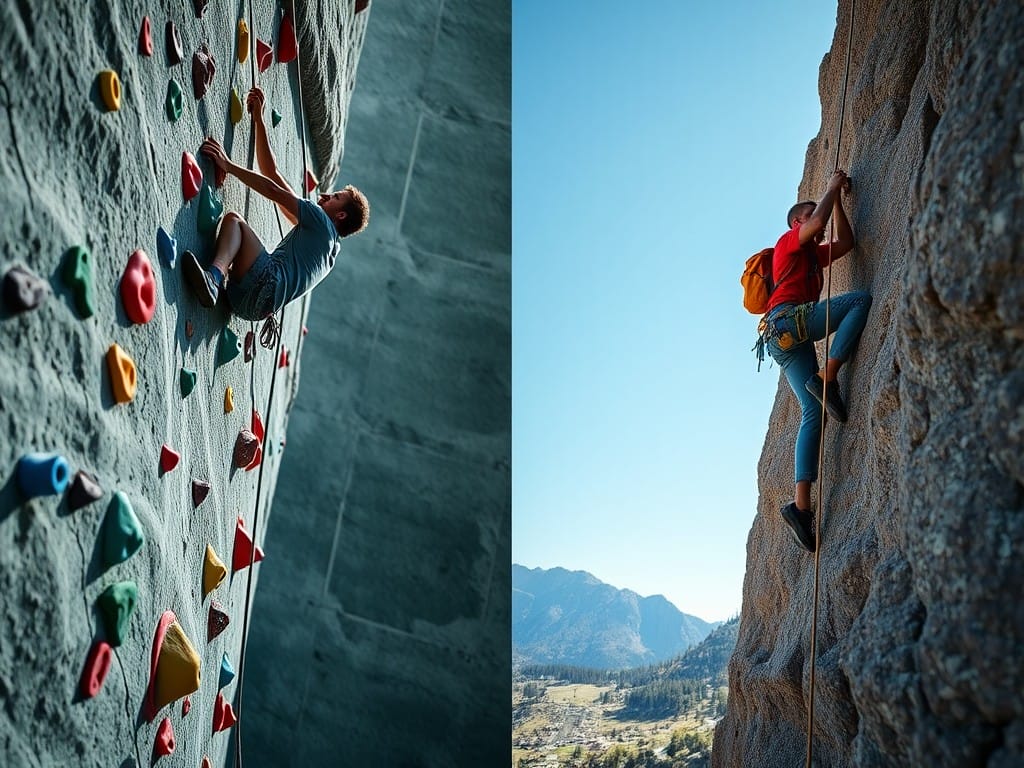Explore the key differences between bouldering and top roping, including their setups, safety, skill development, and community aspects.
Bouldering and top roping are two widely enjoyed climbing styles that appeal to enthusiasts for various reasons. Each offers distinct challenges and experiences tailored to different skill levels. By comparing these styles, climbers can gain insight into which approach aligns with their preferences and goals. Bouldering focuses on shorter climbs without ropes, relying on crash pads for safety, while top roping involves higher ascents secured by ropes and harnesses. Exploring these differences will help climbers choose the best fit for their climbing journey.(1)
Key Takeaway
- Bouldering focuses on shorter climbs without ropes, while top roping involves taller climbs with safety gear.
- The physical demands differ, with bouldering emphasizing strength and power, and top roping focusing on endurance.
- Each style fosters its own community and requires different equipment.
Definition and Setup
Bouldering involves climbing shorter walls, usually up to 20 feet, without ropes or harnesses. Climbers depend on crash pads placed on the ground for safety during falls. These thick mats cushion impacts and protect climbers when they fall. In bouldering, routes are known as “problems,” each presenting a unique set of challenges that require a mix of strength, balance, and technique to solve.
Climbers often spend time analyzing a problem before attempting it, scouting for the best holds and planning their moves carefully. Bouldering can take place indoors at climbing gyms or outdoors on natural rock formations. Indoor gyms typically feature various walls with different angles and holds, while outdoor bouldering encourages a connection with nature. Climbers relish the thrill of tackling problems and the satisfaction of reaching the top, making bouldering a fun and rewarding activity.
Top roping allows climbers to ascend taller walls secured by a rope running from a belayer at the base to an anchor point at the top of the climb. The belayer manages the rope, taking up slack and catching the climber in case of a fall. This style is particularly popular among beginners because it provides a strong sense of security. The rope supports climbers throughout their ascent, enabling them to focus on their technique and movements without the worry of falling far.
The belayer plays a crucial role, needing to stay attentive to the climber’s movements and ready for any falls. Setting up a top rope requires knowledge of anchors and safety procedures. A secure anchor point is essential for the climber’s safety. Climbers practice clear communication with their belayer to maintain a safe and enjoyable experience.
Safety

While bouldering carries risks from falls, crash pads and spotters greatly reduce potential injuries. Spotters stand near the climber to help guide their fall and direct them toward a safe landing area. This extra layer of support is especially beneficial when climbing outdoors. Nonetheless, falls can still be significant if not managed properly, so climbers must proceed with caution. It’s important to assess the environment before starting a climb.
Checking for obstacles on the ground, such as rocks or uneven surfaces, can help prevent injuries during a fall. Practicing proper landing techniques is crucial. Climbers should aim to land on their feet and roll to absorb the impact, which lowers the risk of injury and helps boost their confidence when tackling various problems. Warming up before attempting new problems is essential for injury prevention.
Stretching and practicing easier climbs can prepare the body for more challenging moves. By staying mindful and taking precautions, climbers can enjoy bouldering more safely. Generally considered safer than bouldering, top roping offers constant support from the rope. Climbers are secured, minimizing how far they can fall, significantly reducing the injury risk compared to bouldering.
The belayer’s role is vital in ensuring safety during top roping. They must remain focused on the climber and manage the rope effectively by taking up slack as the climber ascends and being ready to catch them if they fall. Open communication between the climber and belayer is crucial for preventing accidents. Even with the added security of top roping, climbers need to be aware of their surroundings.
They should check that the area below is free of obstacles and that the anchor points at the top are secure. Regular equipment checks, including the rope and harness, are also key to ensuring everything is in good condition. Top roping allows climbers to focus on improving their skills while building confidence. The safety measures in place help climbers enjoy the experience while minimizing risks. Following these safety practices makes top roping a popular and accessible option for many climbers.
Skill Development
Bouldering emphasizes the development of power, technique, and problem-solving skills. Climbers face short and often complex climbing problems that require quick thinking and creativity. Each problem presents unique challenges, encouraging climbers to analyze their movements and devise effective strategies. As climbers engage in bouldering, they learn to use their bodies in various ways.
They practice techniques such as dynamic moves where they jump or reach for holds and static moves, which involve slower, more deliberate motions. This variety helps improve their coordination and control. Bouldering also fosters creative thinking. Climbers often explore different routes and approaches, learning what works best for them.
The problem-solving aspect can be incredibly rewarding, as completing a difficult problem brings a satisfying sense of accomplishment. As they progress, climbers can take on more challenging problems, pushing their limits and enhancing their skills. Overall, bouldering is a great way to develop strength, technique, and creativity in climbing. Top roping focuses on endurance and technique, especially over longer climbs.
This style allows climbers to practice various techniques without the immediate fear of falling, making it particularly well-suited for beginners learning the basics of climbing. In top roping, climbers concentrate on building stamina while ascending taller walls. They can practice foot placements, handholds, and body positioning crucial skills in climbing. With a belayer managing the rope, climbers have the flexibility to take breaks when needed.
This ability is especially beneficial for newcomers who may require extra time to recover between moves. Top roping also teaches climbers the importance of safety and communication. Learning to work with a belayer builds trust and teamwork, essential components for more advanced climbing styles in the future. As climbers gain confidence and experience, they can tackle more challenging routes. This gradual progression allows them to develop their skills while enjoying the climbing journey. (2)
Source : Julia Casey
Physical Demands
Bouldering requires explosive strength and agility since climbs are short yet physically demanding. The brief duration of each climb calls for climbers to give their all in a limited amount of time. They must tap into their power to pull themselves up quickly and efficiently. Without a rope to rest on during their ascent, climbers can experience fatigue rapidly. This makes physical conditioning vital for bouldering.
Many climbers engage in strength training and agility drills to prepare for their climbs. Exercises that target core strength, upper body power, and leg muscles prove extra beneficial. Mental focus is also essential. The competitive nature of bouldering requires climbers to think through their next moves while managing their energy levels.
Mastering the balance between power and technique is key to succeeding in this style of climbing. In summary, bouldering challenges climbers both physically and mentally, making it a fulfilling endeavor for those looking to enhance their fitness and climbing skills. While top roping still requires strength and technique, it allows climbers to utilize resting positions by leaning back against the rope. This feature makes it less demanding over longer routes compared to bouldering, as climbers can take breaks whenever they need.
This ability to rest helps maintain energy throughout their ascent. During top roping, climbers concentrate on endurance as they tackle longer climbs. They build stamina by climbing longer and harder routes, so they can climb for longer without getting tired. Additionally, top roping emphasizes proper technique.
Climbers learn how to position their bodies, distribute weight effectively, and use their legs to drive upward. This focus on technique not only aids climbing efficiency but also reduces muscle strain. Overall, top roping is a good way to build strength, endurance, and climbing skills. Climbers can enjoy climbing taller walls and learn from others in a supportive environment.
Community and Environment
Bouldering has a lively social scene, both indoors and outdoors, where climbers share tips and offer support. Without ropes, the atmosphere feels more laid-back, making it easy to connect with others. Groups often gather by the wall to chat about climbing strategies and cheer each other on. In these environments, climbers can make new friends and share their experiences, making climbing even more fun.
This sense of community makes bouldering even better, as everyone supports each other. When someone finishes a tough climb, everyone cheers, building strong friendships. Outdoor bouldering trips promote this community spirit even further. Top roping is more organized, with climbers teaming up and talking as they climb.
This bonding experience leads to lasting friendships and a deeper appreciation for the sport. Overall, bouldering creates a welcoming and friendly atmosphere for climbers of all levels. Top roping is more organized, with climbers teaming up and talking as they climb. While this can create camaraderie, it may feel less communal than the bouldering experience.
In top roping, climbers depend on their belayers for safety and support, fostering trust and collaboration. During a top roping session, climbers commonly take turns ascending and belaying. This experience helps them understand each other’s roles and responsibilities. Belaying teaches partners to trust each other and build strong friendships, even in a structured setting.
In climbing gyms, top roping sessions may follow a schedule. Allowing climbers to plan their time effectively. Some gyms host group events or classes, bringing climbers together to practice and share their knowledge. Top roping also helps people connect and make friends, even if the vibe is a bit different from bouldering.
Equipment

Bouldering requires minimal equipment primarily climbing shoes and chalk. Climbing shoes are specially crafted for grip and support, allowing climbers to feel the rock beneath their feet. Chalk keeps hands dry, improving grip and reducing the chance of slipping during climbs. When climbing outdoors, crash pads are used to cushion falls. These thick mats protect climbers from falls, making it easier for them to try new things without worrying too much about getting hurt.
Bouldering gear is simple, so it’s easy for beginners to start climbing. With little equipment needed, bouldering encourages spontaneity. Climbers can quickly set up and start climbing, whether at a gym or a natural bouldering site. This ease of access adds to the fun, allowing climbers to immerse themselves in the experience and the climb. Bouldering’s minimal gear makes it easy for many climbers to get started and enjoy the sport without much hassle or preparation.
Top roping requires more gear, such as a harness, rope, belay device, and sometimes quickdraws for lead climbing. Each piece is essential for ensuring safety during climbs. A harness secures climbers to the rope, keeping them safely attached as they ascend. The rope is crucial in top roping, running from an anchor point at the top of the climb to the belayer below, who manages it to catch any falls.
Belay devices allow the belayer to control the rope’s tension, ensuring the climber’s safety. Each component plays a vital role in creating a secure climbing experience. As climbers gain experience, they may incorporate quickdraws and other gear for lead climbing. This progression requires additional training and knowledge about safe gear usage.
It’s important to understand and use this equipment correctly to have a safe and fun climbing experience. While the gear needed for top roping may seem overwhelming initially. it also provides a sense of security. With the right equipment, climbers can focus on improving their skills and staying safe.
Conclusion
Bouldering and top roping each offer unique experiences that cater to different climbing preferences. Bouldering appeals to climbers seeking intense physical challenges in a social atmosphere, while top roping provides a safer environment for developing skills at greater heights. Each style has its advantages, attracting various climbers based on their goals and experiences. For those who enjoy the explosive nature of bouldering, the thrill of tackling problems can be exhilarating. Conversely, climbers who prefer the supportive structure of top roping benefit from increased safety and the opportunity to refine their skills.
Frequently Asked Questions
What’s the main difference between bouldering and top roping?
Bouldering is climbing shorter walls or rocks without ropes, typically with a crash pad below for safety. Top roping involves climbing taller walls or outdoor routes using ropes attached to the top for safety. A partner controls the rope from below. The key difference is the height and safety setup: bouldering relies on pads, while top roping requires ropes and a belay system.
Which is better for beginners?
Both can be great for beginners. Bouldering lets you focus on technique without worrying about gear, while top roping offers more safety with ropes and a partner. If you prefer short, strength-based climbs, bouldering might be your style. If you like longer routes and teamwork, top roping could be the way to go.
Do I need special gear for bouldering or top roping?
For bouldering, you mainly need climbing shoes and a crash pad if you’re outdoors. For top roping, you’ll need climbing shoes, a harness, and a belay device. Most gyms provide gear rentals, so you can try either without buying everything upfront.
Which one is safer?
Both are safe when done correctly. Bouldering has a higher risk of falling since you’re climbing without ropes, but crash pads help reduce injury. Top roping has ropes and a belay system for extra safety, but you need to trust your belay partner and ensure the gear is properly set up.
Does bouldering or top roping build more strength?
Bouldering tends to focus more on strength and explosive moves since the climbs are shorter and more intense. Top roping often requires endurance and mental focus because the routes are longer. Both can build strength in different ways, so it depends on your goals.
Can I do both at the same climbing gym?
Yes, most climbing gyms offer areas for both bouldering and top roping. Bouldering walls are usually shorter and don’t need ropes, while top rope walls are taller and have anchors for the ropes. Trying both can help you figure out which style you enjoy more.
Is bouldering more social than top roping?
It depends on the setting. Bouldering often feels more social because climbers work on problems near each other and share tips. Top roping involves a partner for belaying, so it can feel more team-focused. Both can be social in their own ways, depending on the vibe of the gym or outdoor setting.
Which one is better for improving climbing skills?
Both bouldering and top roping help improve climbing skills but in different ways. Bouldering focuses on strength, problem-solving, and technique for short climbs. Top roping teaches endurance, pacing, and teamwork on longer routes. Mixing both styles can make you a more well-rounded climber.
Related Articles
- https://www.trycrawl.com/common-questions/bouldering-vs-top-rope-climbing-whats-the-difference
- https://inspirerock.com/blog/why-you-should-try-top-rope-climbing/






